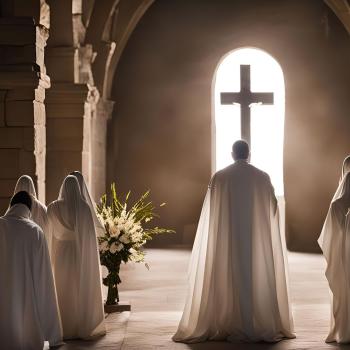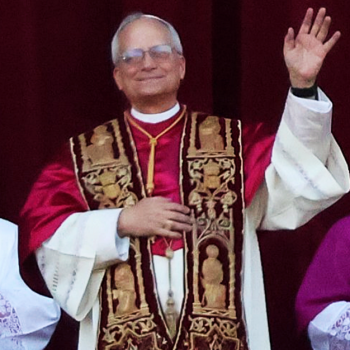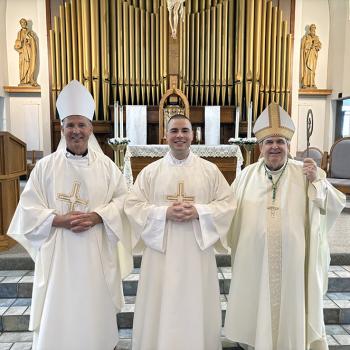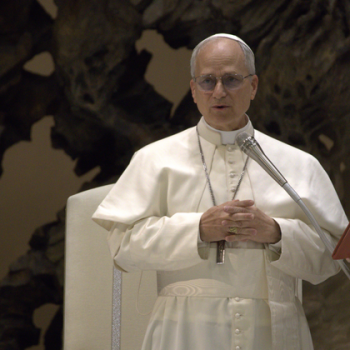
Today is the first Ember Day of autumn, the week after the Feast of the Exaltation of the Holy Cross.
A long time ago, in a world that seems so very far away, Christian traditions rooted in simple faith thrived among the flock. One such tradition is the celebration of what are known as Ember Days. Traditionally, the first Wednesday after Guadete Sunday is the first Ember Day of Winter.
What are these mysterious days of penance and fasting? Their name alone evokes thoughts of a glimmer of light shed upon a dark world. And yet the story of the practice of this devotion has nothing to do with embers, kindling, or ashes, though it is true that the image of glowing splinters of hot coals did appear in my mind’s eye when I first learned of them. They still do.
As it turns out, Ember Days have more to do with Vivaldi’s Four Seasons, than they do with glowing embers, or mysterious bonfires on dark nights. But I daresay I believe that they have something very much to do with keeping the fire of the Christian Faith alive. As such, I’ll break out my torch and go hunting for answers on this solemnity with the cool name. Join me, will you?
In the early Church, the celebration of these particular days was not just left to the flock as a mere devotion. No. Their significance was of such importance that they were added to the liturgical calendar, and celebrated four times throughout the year in conjunction with the changing of the seasons.
Some scholars argue that they may have been instituted from the very beginning of the Church, possibly by St. Paul and his successors, as a way of bringing those living in the Roman Empire to God by means of consecrating already existent celebrations devoted to their pagan gods. In terms of the Ember Days, see, the old saw that pagan practices were co-opted by Christians is absolutely true. By reorienting folks towards giving thanks to the one true God, see, Christianity made the old practice both new and true. There may even be an Old Testament connection to the rise of this practice as well, as we’ll see below.
A few months back, I shared a post with a caricature of Hilaire Belloc that had the following inscription. “Now the Faith is not taught. It is inhabited and breathed in.” I went looking for more on that line of thought and found a snippet of it available on Google Books, but alas, not much more.
Now the Faith is not taught. It is inhabited and breathed in. They that are fed upon it when their characters are being made belong to it. They never can be lost to it finally. It makes them.
That quote is from page 209 of a book edited by Robert Speaight, published in 1958, with the simple title of Letters from Hilaire Belloc. I do not know to whom he was writing, but suffice it to say that in a way, he was writing to you and to me.
Back to the subject at hand, I asked my wife if she had ever heard of the Ember Days, and she, though a Catholic for her entire life, confessed that she never had. Neither had my children, who are ignorant of them no more. Before I became a Catholic, I had never heard of them either. No surprise that, as I am always the last one to know. Besides, I was a Protestant, and since the custom was never mentioned in the Bible, it was lost on me. It didn’t exist, and even if it did, it was some man-made silliness that was all wrong, not biblical, etc., etc.
But what was lost has been found, and that is what learning of the Ember Days is like for me. I mean, the whole reason I wound up being a Catholic is because I wanted to get right with my faith. I’ve written long, and often, about how that came to be. As I came to embrace my faith more and more, I found that what I really wanted to do was eat, sleep, and breathe it. Breathe it in like I breathe air in order to live. Swim in it like a fish does in the ocean, etc.
Why did Pope Gregory VII introduce them? More on that below, but here is the quick and dirty from the Catholic Encyclopedia,
The purpose of their introduction, besides the general one intended by all prayer and fasting, was to thank God for the gifts of nature, to teach men to make use of them in moderation, and to assist the needy.
Searching the web, and clawing though the stacks over at the handy, dandy, YIMCatholic Bookshelf , I unearthed the following chapter from a book published in 1910 called A Pulpit Commentary. Chapter XV, written by a priest named H. G. Hughes, sheds all kinds of light on this heretofore mysterious, and henceforth simply awesome, celebration of what came to be known as the Ember Days. I think you’ll agree with me that bringing them back to prominence would be beneficial to the life of all Christians. Father Hughes now has the floor (bold highlights are mine).
XV. EMBER DAYS
By The Rev. H. G. Hughes
“Thus saith the Lord of Hosts: The fast of the fourth month, and the fast of the fifth, and the fast of the seventh, and the fast of the tenth shall be to the house of Juda joy and gladness and great solemnities.”—Zach. viii, 19.
The Catholic Church, dear brethren in Jesus Christ, from the very beginning of her divinely appointed mission, has ever inculcated upon her children the utility, the necessity and the duty of fasting, as a means of doing penance and subduing the flesh to the spirit. The reasons for this have been explained in a former sermon in this course of instructions, and it is, therefore, unnecessary for me to dwell upon them now. I propose now to treat of four special seasons of fasting and prayer which the Church prescribes during the year, and which we know by the name of Ember Days. This name, once erroneously connected with a kind of cake baked upon hot ashes or embers, is derived with more probability by modern writers from the Latin term “Quatuor Tempora,” or the “four times” of fasting, of which term “Ember” is a corruption. [See the “Catholic Encyclopedia,” Art. Ember Days.]In some old writers the Ember Days are spoken of as the “Three Times”; but this is easily understood by the fact that the great Lenten fast somewhat overshadows the Ember Days which occur at that season of the year.
The history of the Ember Days can be traced very far back in the life of the Church. There is little doubt, indeed, that we have in them an instance of a heathen custom taken over by the Church and Christianized, with that practical wisdom for which she is justly admired, and which knows how to take the elements of good that are to be found in man’s natural religious instincts, and to purify them and elevate them to that supernatural order with which she is the medium of communication for men.
The original deities of the Roman people were all connected with agriculture, upon which art men depend for their daily bread. Hence it was the custom in ancient Rome to hold religious services in honor of these gods in June, September and December, and to invoke their protection upon the fruits of the earth. This idea in itself was entirely right and good, though its expression was directed to false deities. By the establishment of the Ember Days the Church recalled men to the right path and taught them to acknowledge the one true God, the Giver of all good; and, particularly, at these four seasons to thank Him for the gifts of nature or to invoke the divine blessing upon the crops; to use God’s gifts also in moderation, and by the almsgiving, which the Church has always associated with fasting and prayer, to assist their needy brethren.
We can see, moreover, in the days of the week set apart for the Ember fast, a most interesting survival of the weekly religious observances which obtained in the early Church. From the homilies of St. Leo the Great we know that it was customary to fast and to hold meetings for special prayer every Wednesday and Friday. Further, in accordance with the primitive custom by which the solemn celebration of Holy Mass on festival days was preceded by a vigil of prayer and fasting, we find the Saturday also dedicated to this pious practice in preparation for the festal celebration of the Christian Sabbath, the first day of the week, known as the “Lord’s Day.” Hence it is that the Ember Days fall on Wednesday, Friday, and Saturday. [See Duchesne: “Origines du Culte Chretien,” Paris, 1898, pp. 222, 223.] Thus from the earliest times the Church exhibited the salutary tendency to set apart not only the Sunday, but other days for special acts of worship and devotion, teaching us thereby that our religion should be part of our daily lives, and not put off and on with our Sunday clothes; that, in a word, man owes his whole life and every moment of his time to the service of his Creator.
It is not unlikely that the Jewish practise mentioned in the word of my text also had its influence upon the Church in the establishment of theEmber Days. “Thus saith the Lord of Hosts: the fast of the fourth month, and the fast of the fifth, and the fast of the seventh, and the fast of the tenth shall be to the house of Juda joy and gladness and great solemnities” (Zach. viii, 19).
Enough has been said, dear brethren, concerning the history of the Ember Days to show you that we have in them a religious observance of which the origin is to be found in those primitive times when the tones of the Master’s voice still resounded as not far off, when it was remembered how He had said, “The days will come when the bridegroom shall be taken away from them: and then they shall fast in those days” (St. Mark ii, 20). The Church, in fact, began her life with a sacred deposit of divine unalterable truth given into her infallible keeping by Jesus Christ and His Apostles. Almost naturally, we may say, and inevitably, yet also under the supernatural guidance of God’s Holy Spirit in the Church, this body of truth, this deposit of divinely revealed teaching, found its expression in various outward acts of devotion. These at first, without doubt, varied in different places, yet all expressed the same truth: it took time, moreover, for the Church to develop her full liturgical and devotional life. At first this development was difficult in face of the relentless persecution that she had to endure, but when peace came at last the work went rapidly forward, and in due time, while still leaving great devotional freedom to the faithful in various times and places, the supreme authority stepped in and imposed certain uniform practises and liturgical rites upon the whole Church. The Ember Days are among these; but the point that I would have you notice is that, although the universal obligation of such observances in some cases did not come till a comparatively late date, the Ember Days themselves, for instance, having been definitely arranged and prescribed for the whole Church by Pope Gregory VII in the eleventh century, yet they have their roots in the far remote past, and in the practises of primitive times, and are the result of a legitimate development of the truth which Jesus Christ and His Holy Apostles taught in the beginning.
We will consider now the special intentions of the Church in the institution of the Ember Days. They are intended to consecrate to God the four seasons of the year; to implore the Divine blessing upon the fruits of the earth, and thank almighty God for their safe harvesting.
After all, dear brethren, although the complicated conditions of modern life may easily make those forget it who are not employed in the actual cultivation of the soil, it is upon the fruits of the earth that all mankind, civilized or uncivilized, ultimately depend for existence. We forget very easily that the staple food which we find upon our tables every day is there because God has given sun and rain in due season. One of the most obvious ways of acknowledging our dependence upon God for these gifts consists in a due moderation and restriction in their use. I say “obvious,” dear brethren, for this mode of acknowledgment naturally suggests itself to the human mind where men have not been sophisticated by the luxuries of modern “civilized” life. It has been shown by modern investigation that the sacred Tubu, which exists almost universally amongst savage races, is based upon this idea of the recognition of God as the Giver of all good things by abstinence from this one or that one of His gifts. [See The Religion of the Primitives, by Mgr. A. Le Roy, Paris, 1909.]
And is it not common-sense to say that an unlimited and greedy indulgence in luxuries of various kinds implies of itself a spirit of independence and of forgetfulness of the fact that we depend upon God as truly as do the birds of the air and the beasts of the field? It follows, then, that a willing moderation is not only a salutary self-denial, but also an acknowledgment of gratitude due to the Father who provides for our necessities—nay, who showers His gifts upon us in so great abundance?
By giving to the poor what we save by self-denial, we carry out more completely the intentions of the Church in appointing the Ember seasons; for not only is this an act of charity most pleasing to God, but it is also a recognition of that common bond of dependence upon Him which, in fact, unites the whole human race in a solidarity of need as children of one heavenly Father to whom we owe all that we have or are. Thus, speaking in a Homily at the Advent Ember season, St. Leo says: “Fasting has ever been the nourishment of virtue. Abstinence is the source of chaste thoughts, of salutary counsel. By voluntary mortifications the flesh dies to its concupiscences and the spirit is renewed in virtue. But, since fasting alone is not sufficient whereby to secure the soul’s salvation, let us add to it works of mercy towards the poor. Let us make that which we retrench from indulgence serve unto the exercise of virtue. Let the abstinence of him that fasts become the meal of the poor man.”
From very early times the Saturday in the Ember weeks has been set apart by the Church for the ordination of her clergy. The reason is easy to see. The spiritual good of the whole Church, and the salvation of the faithful depend, under God’s Providence, to a very great extent upon the zeal and personal holiness of the ministers of the sanctuary. What more urgent object of prayer and fasting, then, than to obtain a great outpouring of the Holy Spirit upon those who, at the Ember seasons, are about to be consecrated to the solemn and responsible duties of the sacred ministry? Here, therefore, we have another intention of the Church in calling upon her children to set apart these days for fasting and special prayer.
Truly, then, when we consider their venerable origin, their practical embodiment of the great truth of the efficacy and necessity of prayer and self-denial, their salutary influence upon the Christian life, and the blessings that their due observance will most certainly draw down upon the Church, is it not a matter of self-reproach, my dear brethren, that we take so little notice of the Ember Days and of other similar observances which played so great a part in the lives of our forefathers in the faith?
And just when you were thinking that the Ember Days were held in high esteem even as late as 1910, Fr. Hughes sounds a wake up call that is as timely today, as it was when he wrote these words “back in the day,”
Should we not hold it to be a sacred duty and a high privilege to forward, each in his own sphere, by word and by example, that happy revival of the devotional and liturgical life of the Church which is to be witnessed today? It is no slight thing to pass over unnoticed a holy institution like that of the Ember Days; for to these things are attached very special graces and blessings which the Church calls down at such times upon her faithful children. We can scarcely expect those blessings if we dissociate ourselves by our forgetfulness or indifference from those Catholic ordinances which are their ordinary vehicle. There is a sacred virtue in those ordinances; for they are, as it were, the official acts, and the official pleadings of the Church as appointed intermediary between God and man; exercising her mediation through that priesthood which is on earth the continuation of and participation in the Eternal Priesthood of Jesus Christ Himself, who, indeed, carries on through Church and priest, who are in intimate union and co-operation with Him, His own mediatorial office. And has not St. John told us in the Apocalypse that we are all—in our corporate capacity, that is, as members of the Church—”a kingdom and priests to God?” It is, then, both a duty and a privilege, a duty not to be neglected, and a privilege not to be despised, to unite ourselves with the Church in those special rites and ceremonies which she has instituted for our common observance as members of Christ’s mystical Body.
Lastly, my dear brethren, we must always remember that the outward expressions of piety, of repentance and devotion, these bodily fasts and mortifications, are but a means to an end: that they are meant to aid us in that continual fast and abstinence from all sinful pleasures which is the daily obligation of every Christian, and is not to be confined to any special times or seasons. The interior spirit, then, in which we should follow the Church in these holy observances, the spirit without which they would be vain and useless indeed, is summed up admirably in one of the prayers in the Mass for the Ember Saturday during the season of Pentecost: “Grant, we beseech Thee, almighty God, that, being taught by these salutary fasts, and abstaining likewise from all vices, we may the more easily obtain thy mercy—through Jesus Christ, our Lord.”
From other sources, I learned that after Vatican II, the celebration of this Solemnity, and others like them, was left up to the decision of local councils of bishops. In Europe, for example, it appears that Ember Days are celebrated quite regularly in rural parishes, though not so much in the big cities. In the United States, since the Mass of Paul VI was instituted, no instructions have been handed down as yet regarding putting the Ember Days back on the calender.
As Hilaire Belloc wrote in the same letter I quoted earlier,
Plenty of moral fresh air in that critical time would restore the future on the lines of the past. But how is one to secure it? In individual cases one can see it–but who spread the example? Of course, to begin at the beginning, the spread of the Faith would do the whole thing. But meanwhile it is worth spreading the effects–which are more easily swallowed than the whole thing.”
Which is why I’ll be celebrating the Ember Days, here on out through my pilgrimage here on Earth, just like my rebellious friends at Southern Fried Catholicism. The blog Rorate Caeli ran a post sharing the wonderful essay, The Glow of these Ember Days, written by Michael P. Foley, of Baylor University. Therein, I learned about what Shrimp Tempura has to do with the celebration of this solemnity.
In fact, now that I know about Ember Days, I can’t seem to get this song out of my head, so I’ll share it with you.
This post was first published on May 31, 2012 and revised for Advent. More information about Ember Days can be found below,
UPDATES (9/18/2013)
A Modest Proposal to Pope Francis—Restore the Ember Days!
City Father: Ember Days.















